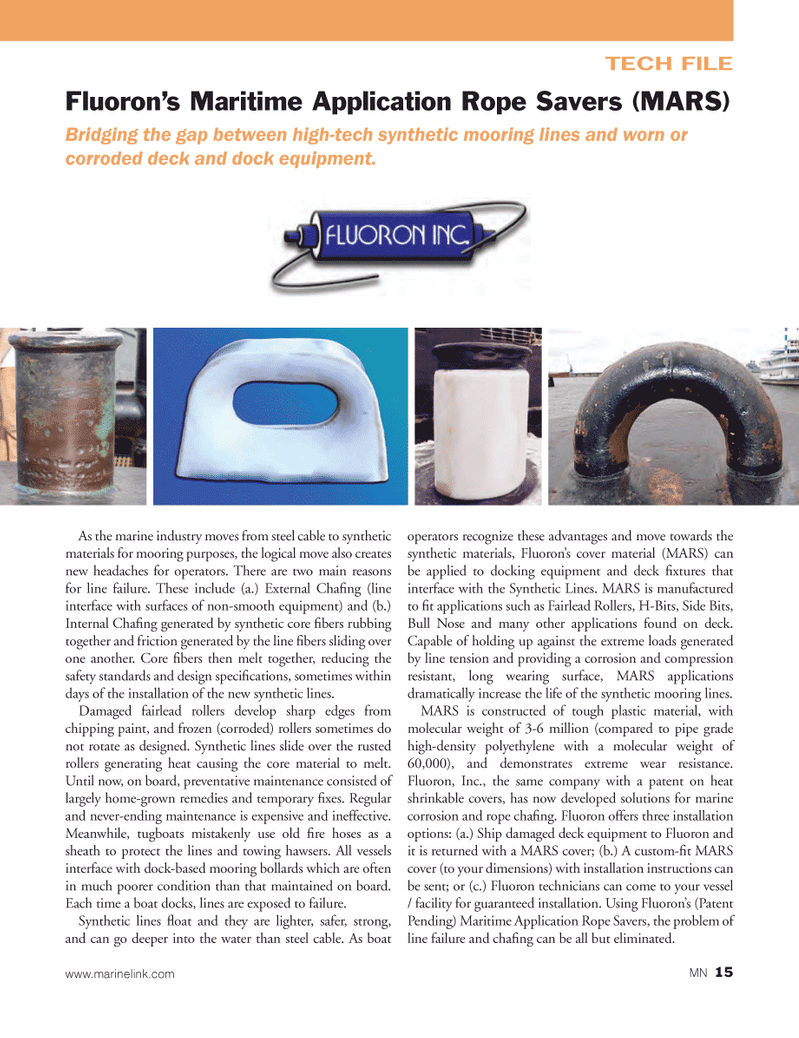
Page 15: of Marine News Magazine (August 2012)
Salvage & Recovery
Read this page in Pdf, Flash or Html5 edition of August 2012 Marine News Magazine
TECH FILEAs the marine industry moves from steel cable to synthetic materials for mooring purposes, the logical move also creates new headaches for operators. There are two main reasons for line failure. These include (a.) External ChaÞ ng (line interface with surfaces of non-smooth equipment) and (b.) Internal ChaÞ ng generated by synthetic core Þ bers rubbing together and friction generated by the line Þ bers sliding over one another. Core Þ bers then melt together, reducing the safety standards and design speciÞ cations, sometimes within days of the installation of the new synthetic lines. Damaged fairlead rollers develop sharp edges from chipping paint, and frozen (corroded) rollers sometimes do not rotate as designed. Synthetic lines slide over the rusted rollers generating heat causing the core material to melt. Until now, on board, preventative maintenance consisted of largely home-grown remedies and temporary Þ xes. Regular and never-ending maintenance is expensive and ineffective. Meanwhile, tugboats mistakenly use old Þ re hoses as a sheath to protect the lines and towing hawsers. All vessels interface with dock-based mooring bollards which are often in much poorer condition than that maintained on board. Each time a boat docks, lines are exposed to failure. Synthetic lines ß oat and they are lighter, safer, strong, and can go deeper into the water than steel cable. As boat operators recognize these advantages and move towards the synthetic materials, FluoronÕs cover material (MARS) can be applied to docking equipment and deck Þ xtures that interface with the Synthetic Lines. MARS is manufactured to Þ t applications such as Fairlead Rollers, H-Bits, Side Bits, Bull Nose and many other applications found on deck. Capable of holding up against the extreme loads generated by line tension and providing a corrosion and compression resistant, long wearing surface, MARS applications dramatically increase the life of the synthetic mooring lines. MARS is constructed of tough plastic material, with molecular weight of 3-6 million (compared to pipe grade high-density polyethylene with a molecular weight of 60,000), and demonstrates extreme wear resistance. Fluoron, Inc., the same company with a patent on heat shrinkable covers, has now developed solutions for marine corrosion and rope chaÞ ng. Fluoron offers three installation options: (a.) Ship damaged deck equipment to Fluoron and it is returned with a MARS cover; (b.) A custom-Þ t MARS cover (to your dimensions) with installation instructions can be sent; or (c.) Fluoron technicians can come to your vessel / facility for guaranteed installation. Using FluoronÕs (Patent Pending) Maritime Application Rope Savers, the problem of line failure and chaÞ ng can be all but eliminated. Fluoron?s Maritime Application Rope Savers (MARS) Bridging the gap between high-tech synthetic mooring lines and worn or corroded deck and dock equipment. MN 15www.marinelink.com

 14
14

 16
16
